Human Resource Management Report: Practices, Analysis and Application
VerifiedAdded on 2022/12/03
|14
|4107
|257
Report
AI Summary
This report provides a comprehensive overview of Human Resource Management (HRM), addressing its purpose and scope in terms of resourcing an organization with appropriate talent and skills to fulfill business objectives. It examines the various functions of HRM, including recruitment and selection, benefits and compensation, employee relations, talent development, health and safety, and rewards and appraisal. The report analyzes the strengths and weaknesses of different recruitment and selection approaches, such as internal and external recruitment, and job analysis methods. It also evaluates the effectiveness of key HRM practices, including performance management, training and development, and relationship management, in raising organizational profit and productivity. Furthermore, the report explores the importance of employee relations in influencing HRM decision-making and identifies key elements of employment legislation. Finally, it illustrates the application of HRM practices in a work-related context with specific examples, providing a practical understanding of HRM's role in organizational success. The report is a valuable resource for students seeking to understand the complexities of HRM and its impact on modern businesses.
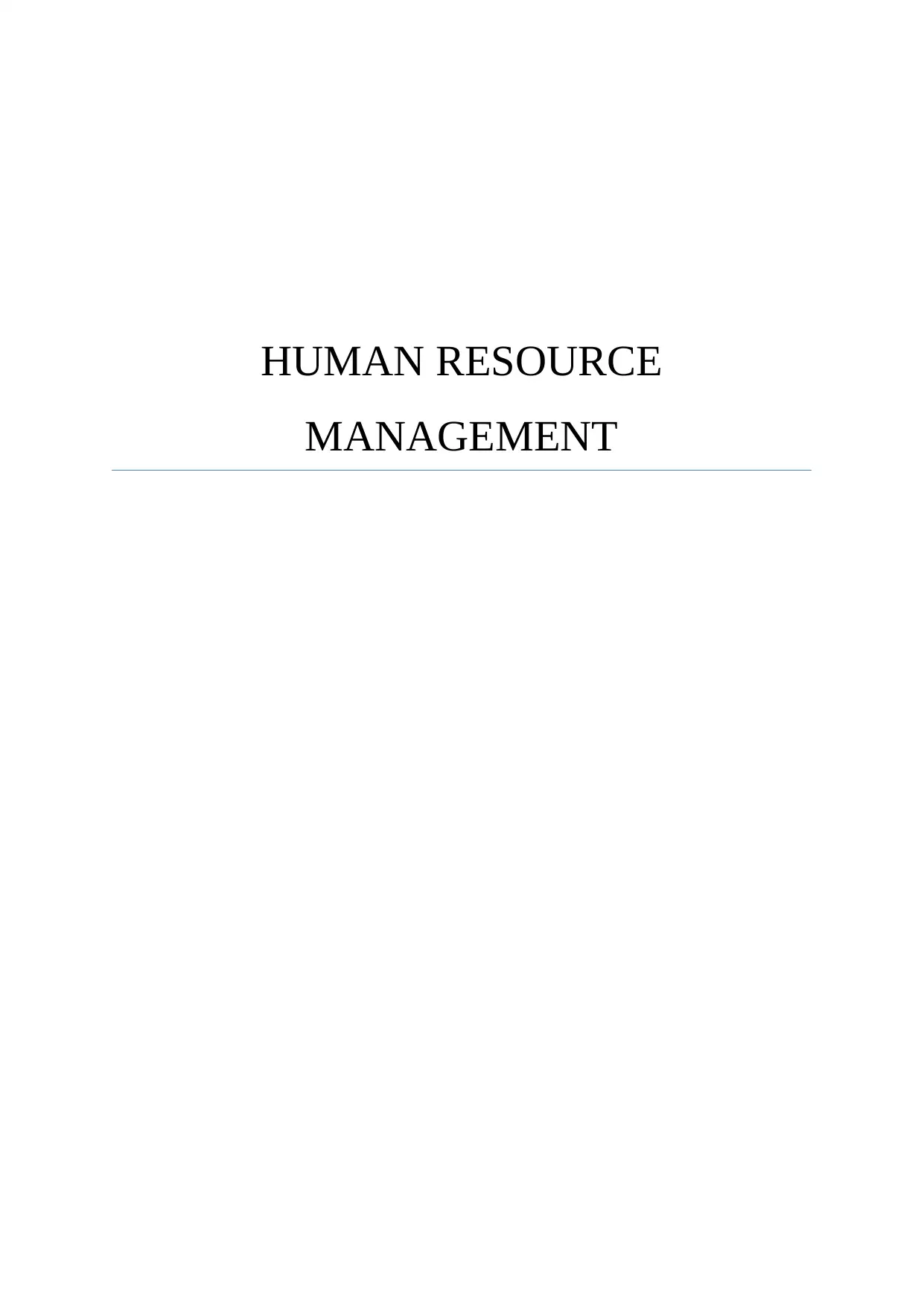
HUMAN RESOURCE
MANAGEMENT
MANAGEMENT
Paraphrase This Document
Need a fresh take? Get an instant paraphrase of this document with our AI Paraphraser
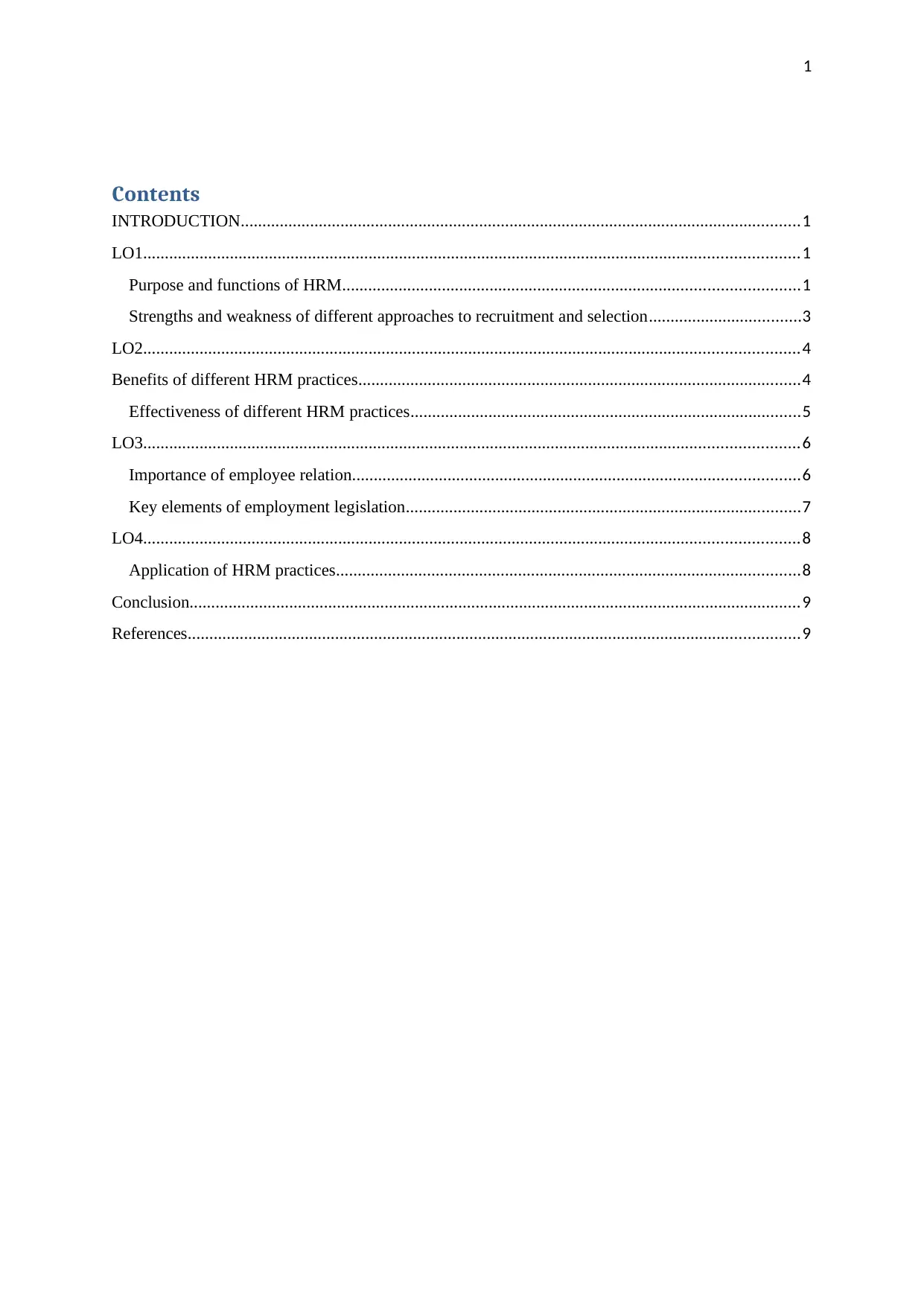
1
Contents
INTRODUCTION.................................................................................................................................1
LO1.......................................................................................................................................................1
Purpose and functions of HRM.........................................................................................................1
Strengths and weakness of different approaches to recruitment and selection...................................3
LO2.......................................................................................................................................................4
Benefits of different HRM practices......................................................................................................4
Effectiveness of different HRM practices..........................................................................................5
LO3.......................................................................................................................................................6
Importance of employee relation.......................................................................................................6
Key elements of employment legislation...........................................................................................7
LO4.......................................................................................................................................................8
Application of HRM practices...........................................................................................................8
Conclusion.............................................................................................................................................9
References.............................................................................................................................................9
Contents
INTRODUCTION.................................................................................................................................1
LO1.......................................................................................................................................................1
Purpose and functions of HRM.........................................................................................................1
Strengths and weakness of different approaches to recruitment and selection...................................3
LO2.......................................................................................................................................................4
Benefits of different HRM practices......................................................................................................4
Effectiveness of different HRM practices..........................................................................................5
LO3.......................................................................................................................................................6
Importance of employee relation.......................................................................................................6
Key elements of employment legislation...........................................................................................7
LO4.......................................................................................................................................................8
Application of HRM practices...........................................................................................................8
Conclusion.............................................................................................................................................9
References.............................................................................................................................................9
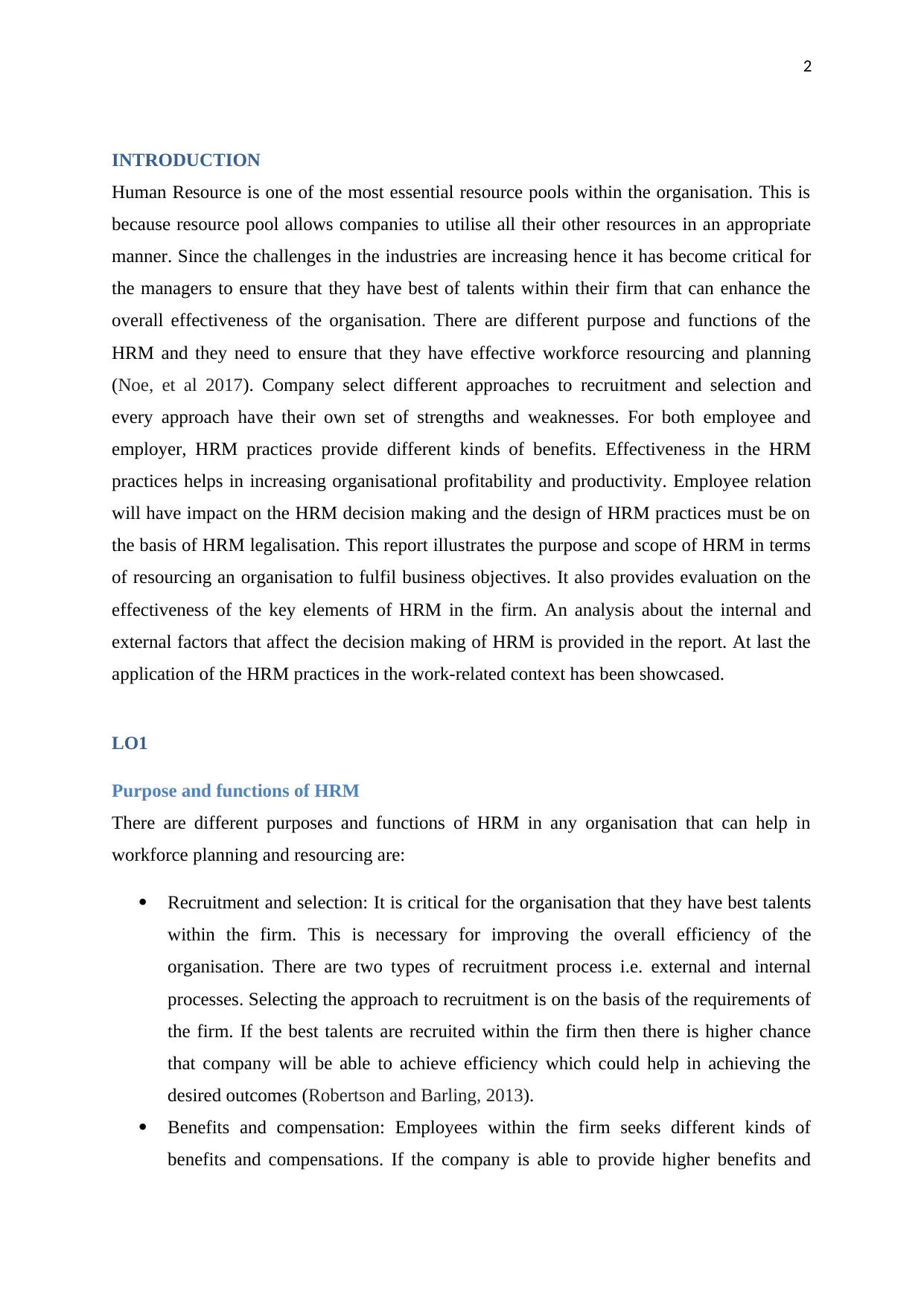
2
INTRODUCTION
Human Resource is one of the most essential resource pools within the organisation. This is
because resource pool allows companies to utilise all their other resources in an appropriate
manner. Since the challenges in the industries are increasing hence it has become critical for
the managers to ensure that they have best of talents within their firm that can enhance the
overall effectiveness of the organisation. There are different purpose and functions of the
HRM and they need to ensure that they have effective workforce resourcing and planning
(Noe, et al 2017). Company select different approaches to recruitment and selection and
every approach have their own set of strengths and weaknesses. For both employee and
employer, HRM practices provide different kinds of benefits. Effectiveness in the HRM
practices helps in increasing organisational profitability and productivity. Employee relation
will have impact on the HRM decision making and the design of HRM practices must be on
the basis of HRM legalisation. This report illustrates the purpose and scope of HRM in terms
of resourcing an organisation to fulfil business objectives. It also provides evaluation on the
effectiveness of the key elements of HRM in the firm. An analysis about the internal and
external factors that affect the decision making of HRM is provided in the report. At last the
application of the HRM practices in the work-related context has been showcased.
LO1
Purpose and functions of HRM
There are different purposes and functions of HRM in any organisation that can help in
workforce planning and resourcing are:
Recruitment and selection: It is critical for the organisation that they have best talents
within the firm. This is necessary for improving the overall efficiency of the
organisation. There are two types of recruitment process i.e. external and internal
processes. Selecting the approach to recruitment is on the basis of the requirements of
the firm. If the best talents are recruited within the firm then there is higher chance
that company will be able to achieve efficiency which could help in achieving the
desired outcomes (Robertson and Barling, 2013).
Benefits and compensation: Employees within the firm seeks different kinds of
benefits and compensations. If the company is able to provide higher benefits and
INTRODUCTION
Human Resource is one of the most essential resource pools within the organisation. This is
because resource pool allows companies to utilise all their other resources in an appropriate
manner. Since the challenges in the industries are increasing hence it has become critical for
the managers to ensure that they have best of talents within their firm that can enhance the
overall effectiveness of the organisation. There are different purpose and functions of the
HRM and they need to ensure that they have effective workforce resourcing and planning
(Noe, et al 2017). Company select different approaches to recruitment and selection and
every approach have their own set of strengths and weaknesses. For both employee and
employer, HRM practices provide different kinds of benefits. Effectiveness in the HRM
practices helps in increasing organisational profitability and productivity. Employee relation
will have impact on the HRM decision making and the design of HRM practices must be on
the basis of HRM legalisation. This report illustrates the purpose and scope of HRM in terms
of resourcing an organisation to fulfil business objectives. It also provides evaluation on the
effectiveness of the key elements of HRM in the firm. An analysis about the internal and
external factors that affect the decision making of HRM is provided in the report. At last the
application of the HRM practices in the work-related context has been showcased.
LO1
Purpose and functions of HRM
There are different purposes and functions of HRM in any organisation that can help in
workforce planning and resourcing are:
Recruitment and selection: It is critical for the organisation that they have best talents
within the firm. This is necessary for improving the overall efficiency of the
organisation. There are two types of recruitment process i.e. external and internal
processes. Selecting the approach to recruitment is on the basis of the requirements of
the firm. If the best talents are recruited within the firm then there is higher chance
that company will be able to achieve efficiency which could help in achieving the
desired outcomes (Robertson and Barling, 2013).
Benefits and compensation: Employees within the firm seeks different kinds of
benefits and compensations. If the company is able to provide higher benefits and
⊘ This is a preview!⊘
Do you want full access?
Subscribe today to unlock all pages.

Trusted by 1+ million students worldwide
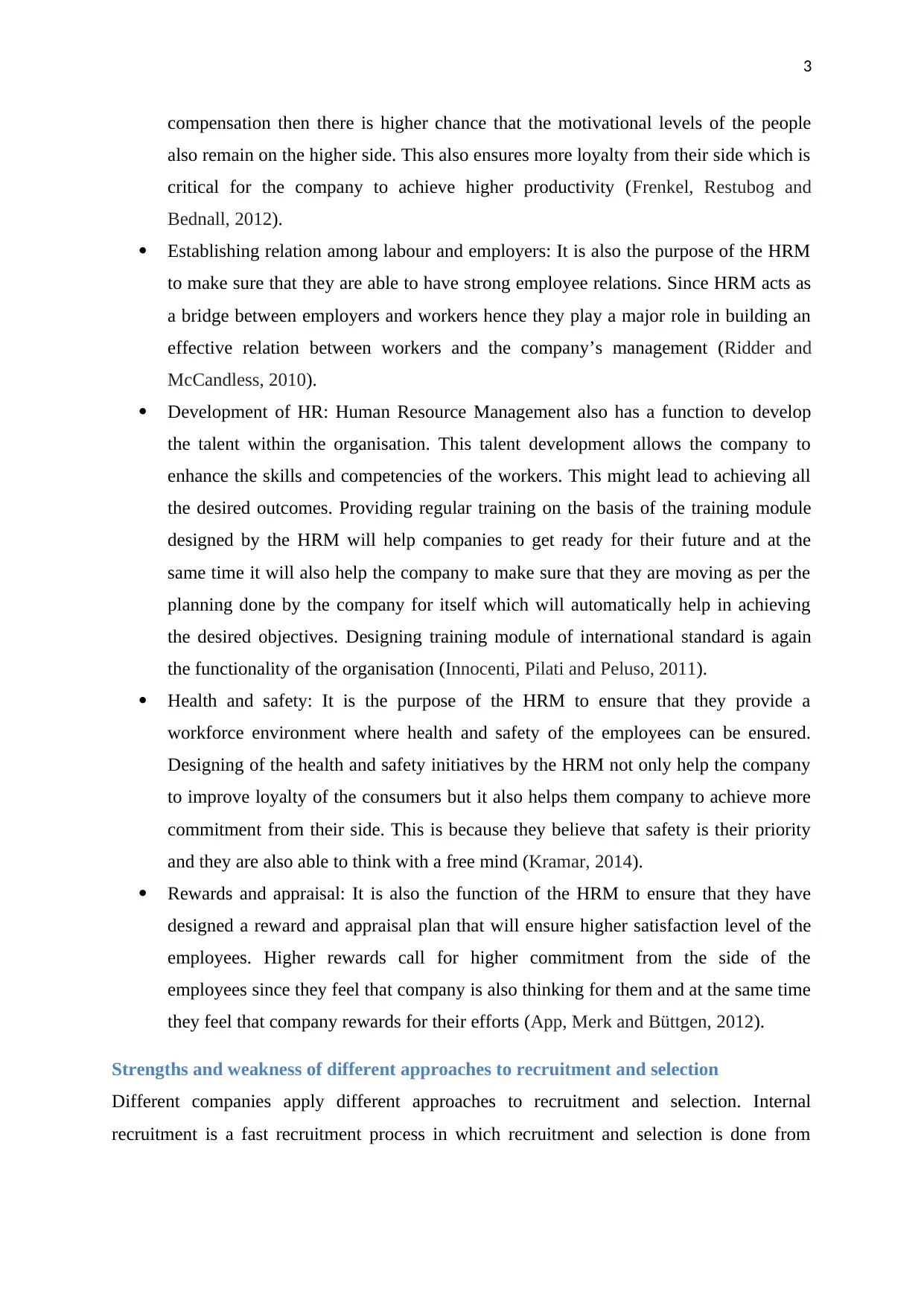
3
compensation then there is higher chance that the motivational levels of the people
also remain on the higher side. This also ensures more loyalty from their side which is
critical for the company to achieve higher productivity (Frenkel, Restubog and
Bednall, 2012).
Establishing relation among labour and employers: It is also the purpose of the HRM
to make sure that they are able to have strong employee relations. Since HRM acts as
a bridge between employers and workers hence they play a major role in building an
effective relation between workers and the company’s management (Ridder and
McCandless, 2010).
Development of HR: Human Resource Management also has a function to develop
the talent within the organisation. This talent development allows the company to
enhance the skills and competencies of the workers. This might lead to achieving all
the desired outcomes. Providing regular training on the basis of the training module
designed by the HRM will help companies to get ready for their future and at the
same time it will also help the company to make sure that they are moving as per the
planning done by the company for itself which will automatically help in achieving
the desired objectives. Designing training module of international standard is again
the functionality of the organisation (Innocenti, Pilati and Peluso, 2011).
Health and safety: It is the purpose of the HRM to ensure that they provide a
workforce environment where health and safety of the employees can be ensured.
Designing of the health and safety initiatives by the HRM not only help the company
to improve loyalty of the consumers but it also helps them company to achieve more
commitment from their side. This is because they believe that safety is their priority
and they are also able to think with a free mind (Kramar, 2014).
Rewards and appraisal: It is also the function of the HRM to ensure that they have
designed a reward and appraisal plan that will ensure higher satisfaction level of the
employees. Higher rewards call for higher commitment from the side of the
employees since they feel that company is also thinking for them and at the same time
they feel that company rewards for their efforts (App, Merk and Büttgen, 2012).
Strengths and weakness of different approaches to recruitment and selection
Different companies apply different approaches to recruitment and selection. Internal
recruitment is a fast recruitment process in which recruitment and selection is done from
compensation then there is higher chance that the motivational levels of the people
also remain on the higher side. This also ensures more loyalty from their side which is
critical for the company to achieve higher productivity (Frenkel, Restubog and
Bednall, 2012).
Establishing relation among labour and employers: It is also the purpose of the HRM
to make sure that they are able to have strong employee relations. Since HRM acts as
a bridge between employers and workers hence they play a major role in building an
effective relation between workers and the company’s management (Ridder and
McCandless, 2010).
Development of HR: Human Resource Management also has a function to develop
the talent within the organisation. This talent development allows the company to
enhance the skills and competencies of the workers. This might lead to achieving all
the desired outcomes. Providing regular training on the basis of the training module
designed by the HRM will help companies to get ready for their future and at the
same time it will also help the company to make sure that they are moving as per the
planning done by the company for itself which will automatically help in achieving
the desired objectives. Designing training module of international standard is again
the functionality of the organisation (Innocenti, Pilati and Peluso, 2011).
Health and safety: It is the purpose of the HRM to ensure that they provide a
workforce environment where health and safety of the employees can be ensured.
Designing of the health and safety initiatives by the HRM not only help the company
to improve loyalty of the consumers but it also helps them company to achieve more
commitment from their side. This is because they believe that safety is their priority
and they are also able to think with a free mind (Kramar, 2014).
Rewards and appraisal: It is also the function of the HRM to ensure that they have
designed a reward and appraisal plan that will ensure higher satisfaction level of the
employees. Higher rewards call for higher commitment from the side of the
employees since they feel that company is also thinking for them and at the same time
they feel that company rewards for their efforts (App, Merk and Büttgen, 2012).
Strengths and weakness of different approaches to recruitment and selection
Different companies apply different approaches to recruitment and selection. Internal
recruitment is a fast recruitment process in which recruitment and selection is done from
Paraphrase This Document
Need a fresh take? Get an instant paraphrase of this document with our AI Paraphraser
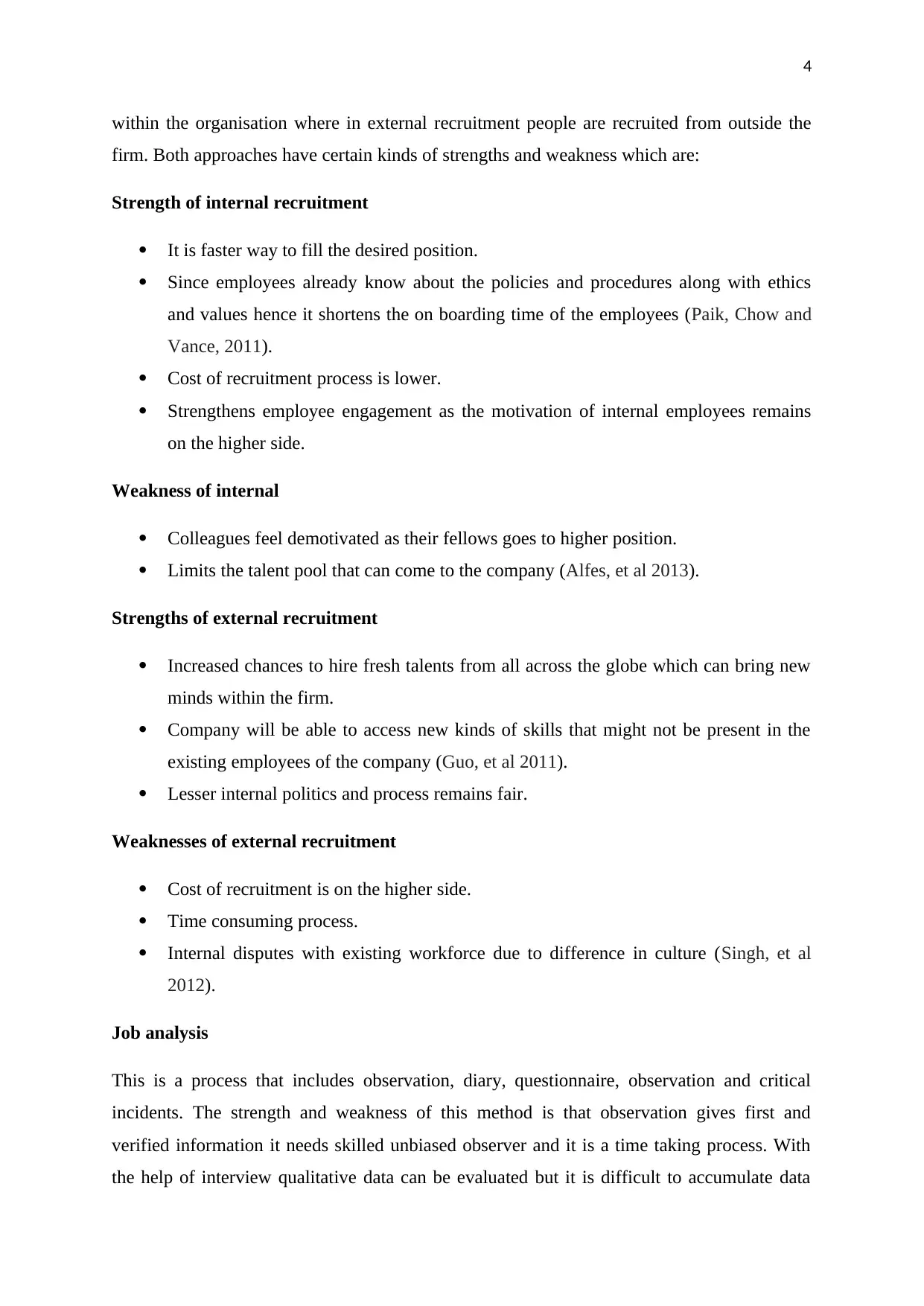
4
within the organisation where in external recruitment people are recruited from outside the
firm. Both approaches have certain kinds of strengths and weakness which are:
Strength of internal recruitment
It is faster way to fill the desired position.
Since employees already know about the policies and procedures along with ethics
and values hence it shortens the on boarding time of the employees (Paik, Chow and
Vance, 2011).
Cost of recruitment process is lower.
Strengthens employee engagement as the motivation of internal employees remains
on the higher side.
Weakness of internal
Colleagues feel demotivated as their fellows goes to higher position.
Limits the talent pool that can come to the company (Alfes, et al 2013).
Strengths of external recruitment
Increased chances to hire fresh talents from all across the globe which can bring new
minds within the firm.
Company will be able to access new kinds of skills that might not be present in the
existing employees of the company (Guo, et al 2011).
Lesser internal politics and process remains fair.
Weaknesses of external recruitment
Cost of recruitment is on the higher side.
Time consuming process.
Internal disputes with existing workforce due to difference in culture (Singh, et al
2012).
Job analysis
This is a process that includes observation, diary, questionnaire, observation and critical
incidents. The strength and weakness of this method is that observation gives first and
verified information it needs skilled unbiased observer and it is a time taking process. With
the help of interview qualitative data can be evaluated but it is difficult to accumulate data
within the organisation where in external recruitment people are recruited from outside the
firm. Both approaches have certain kinds of strengths and weakness which are:
Strength of internal recruitment
It is faster way to fill the desired position.
Since employees already know about the policies and procedures along with ethics
and values hence it shortens the on boarding time of the employees (Paik, Chow and
Vance, 2011).
Cost of recruitment process is lower.
Strengthens employee engagement as the motivation of internal employees remains
on the higher side.
Weakness of internal
Colleagues feel demotivated as their fellows goes to higher position.
Limits the talent pool that can come to the company (Alfes, et al 2013).
Strengths of external recruitment
Increased chances to hire fresh talents from all across the globe which can bring new
minds within the firm.
Company will be able to access new kinds of skills that might not be present in the
existing employees of the company (Guo, et al 2011).
Lesser internal politics and process remains fair.
Weaknesses of external recruitment
Cost of recruitment is on the higher side.
Time consuming process.
Internal disputes with existing workforce due to difference in culture (Singh, et al
2012).
Job analysis
This is a process that includes observation, diary, questionnaire, observation and critical
incidents. The strength and weakness of this method is that observation gives first and
verified information it needs skilled unbiased observer and it is a time taking process. With
the help of interview qualitative data can be evaluated but it is difficult to accumulate data
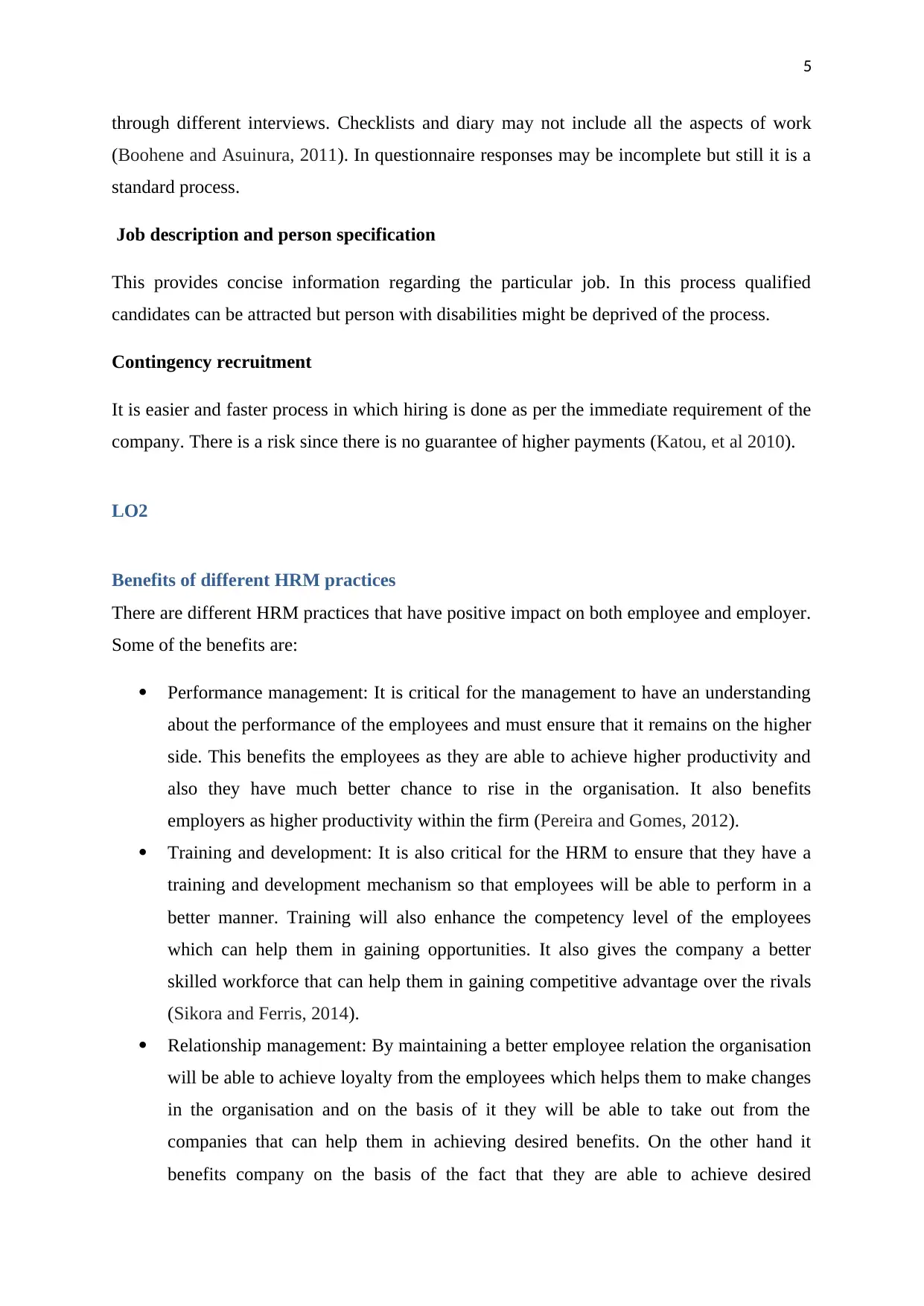
5
through different interviews. Checklists and diary may not include all the aspects of work
(Boohene and Asuinura, 2011). In questionnaire responses may be incomplete but still it is a
standard process.
Job description and person specification
This provides concise information regarding the particular job. In this process qualified
candidates can be attracted but person with disabilities might be deprived of the process.
Contingency recruitment
It is easier and faster process in which hiring is done as per the immediate requirement of the
company. There is a risk since there is no guarantee of higher payments (Katou, et al 2010).
LO2
Benefits of different HRM practices
There are different HRM practices that have positive impact on both employee and employer.
Some of the benefits are:
Performance management: It is critical for the management to have an understanding
about the performance of the employees and must ensure that it remains on the higher
side. This benefits the employees as they are able to achieve higher productivity and
also they have much better chance to rise in the organisation. It also benefits
employers as higher productivity within the firm (Pereira and Gomes, 2012).
Training and development: It is also critical for the HRM to ensure that they have a
training and development mechanism so that employees will be able to perform in a
better manner. Training will also enhance the competency level of the employees
which can help them in gaining opportunities. It also gives the company a better
skilled workforce that can help them in gaining competitive advantage over the rivals
(Sikora and Ferris, 2014).
Relationship management: By maintaining a better employee relation the organisation
will be able to achieve loyalty from the employees which helps them to make changes
in the organisation and on the basis of it they will be able to take out from the
companies that can help them in achieving desired benefits. On the other hand it
benefits company on the basis of the fact that they are able to achieve desired
through different interviews. Checklists and diary may not include all the aspects of work
(Boohene and Asuinura, 2011). In questionnaire responses may be incomplete but still it is a
standard process.
Job description and person specification
This provides concise information regarding the particular job. In this process qualified
candidates can be attracted but person with disabilities might be deprived of the process.
Contingency recruitment
It is easier and faster process in which hiring is done as per the immediate requirement of the
company. There is a risk since there is no guarantee of higher payments (Katou, et al 2010).
LO2
Benefits of different HRM practices
There are different HRM practices that have positive impact on both employee and employer.
Some of the benefits are:
Performance management: It is critical for the management to have an understanding
about the performance of the employees and must ensure that it remains on the higher
side. This benefits the employees as they are able to achieve higher productivity and
also they have much better chance to rise in the organisation. It also benefits
employers as higher productivity within the firm (Pereira and Gomes, 2012).
Training and development: It is also critical for the HRM to ensure that they have a
training and development mechanism so that employees will be able to perform in a
better manner. Training will also enhance the competency level of the employees
which can help them in gaining opportunities. It also gives the company a better
skilled workforce that can help them in gaining competitive advantage over the rivals
(Sikora and Ferris, 2014).
Relationship management: By maintaining a better employee relation the organisation
will be able to achieve loyalty from the employees which helps them to make changes
in the organisation and on the basis of it they will be able to take out from the
companies that can help them in achieving desired benefits. On the other hand it
benefits company on the basis of the fact that they are able to achieve desired
⊘ This is a preview!⊘
Do you want full access?
Subscribe today to unlock all pages.

Trusted by 1+ million students worldwide
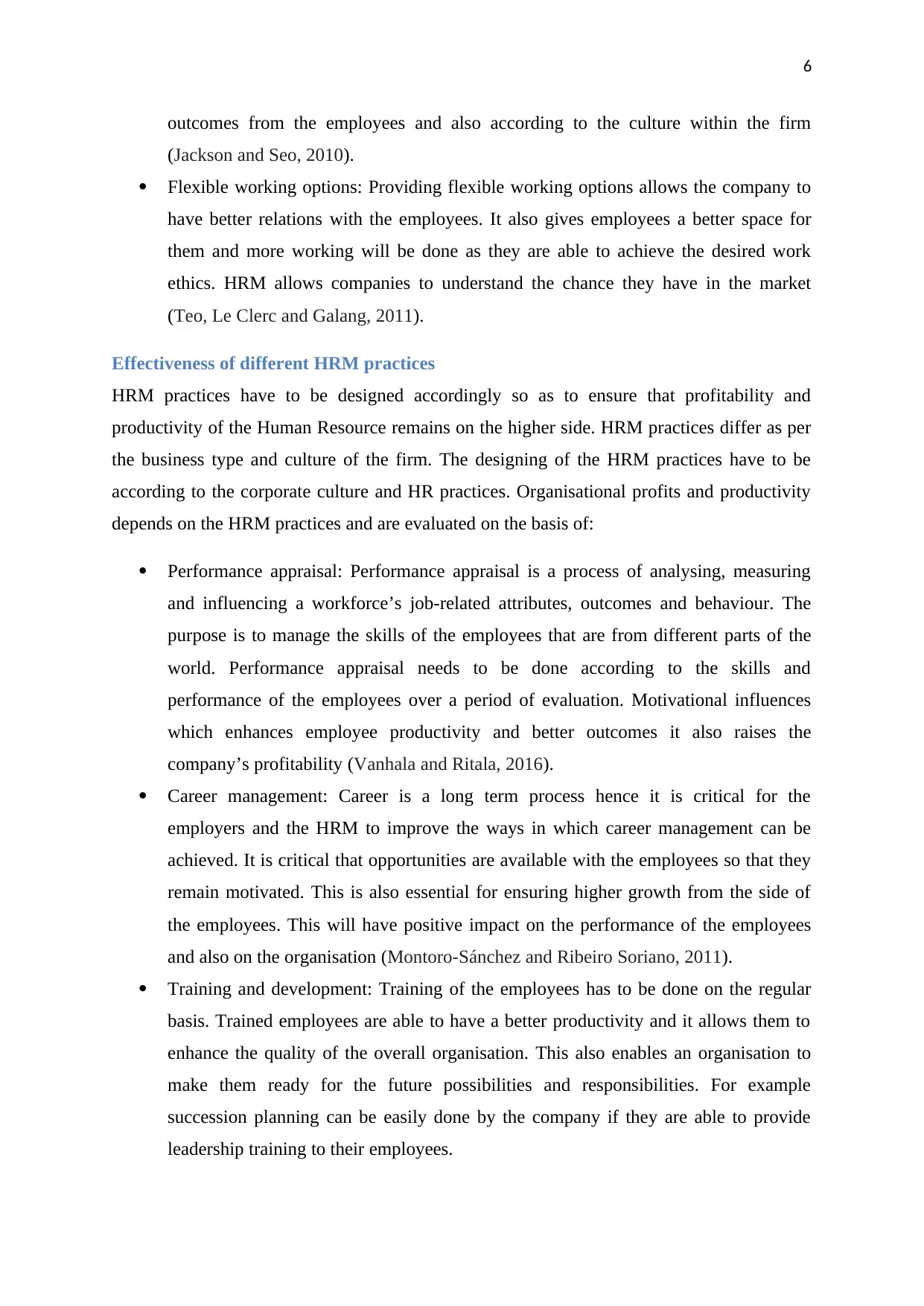
6
outcomes from the employees and also according to the culture within the firm
(Jackson and Seo, 2010).
Flexible working options: Providing flexible working options allows the company to
have better relations with the employees. It also gives employees a better space for
them and more working will be done as they are able to achieve the desired work
ethics. HRM allows companies to understand the chance they have in the market
(Teo, Le Clerc and Galang, 2011).
Effectiveness of different HRM practices
HRM practices have to be designed accordingly so as to ensure that profitability and
productivity of the Human Resource remains on the higher side. HRM practices differ as per
the business type and culture of the firm. The designing of the HRM practices have to be
according to the corporate culture and HR practices. Organisational profits and productivity
depends on the HRM practices and are evaluated on the basis of:
Performance appraisal: Performance appraisal is a process of analysing, measuring
and influencing a workforce’s job-related attributes, outcomes and behaviour. The
purpose is to manage the skills of the employees that are from different parts of the
world. Performance appraisal needs to be done according to the skills and
performance of the employees over a period of evaluation. Motivational influences
which enhances employee productivity and better outcomes it also raises the
company’s profitability (Vanhala and Ritala, 2016).
Career management: Career is a long term process hence it is critical for the
employers and the HRM to improve the ways in which career management can be
achieved. It is critical that opportunities are available with the employees so that they
remain motivated. This is also essential for ensuring higher growth from the side of
the employees. This will have positive impact on the performance of the employees
and also on the organisation (Montoro-Sánchez and Ribeiro Soriano, 2011).
Training and development: Training of the employees has to be done on the regular
basis. Trained employees are able to have a better productivity and it allows them to
enhance the quality of the overall organisation. This also enables an organisation to
make them ready for the future possibilities and responsibilities. For example
succession planning can be easily done by the company if they are able to provide
leadership training to their employees.
outcomes from the employees and also according to the culture within the firm
(Jackson and Seo, 2010).
Flexible working options: Providing flexible working options allows the company to
have better relations with the employees. It also gives employees a better space for
them and more working will be done as they are able to achieve the desired work
ethics. HRM allows companies to understand the chance they have in the market
(Teo, Le Clerc and Galang, 2011).
Effectiveness of different HRM practices
HRM practices have to be designed accordingly so as to ensure that profitability and
productivity of the Human Resource remains on the higher side. HRM practices differ as per
the business type and culture of the firm. The designing of the HRM practices have to be
according to the corporate culture and HR practices. Organisational profits and productivity
depends on the HRM practices and are evaluated on the basis of:
Performance appraisal: Performance appraisal is a process of analysing, measuring
and influencing a workforce’s job-related attributes, outcomes and behaviour. The
purpose is to manage the skills of the employees that are from different parts of the
world. Performance appraisal needs to be done according to the skills and
performance of the employees over a period of evaluation. Motivational influences
which enhances employee productivity and better outcomes it also raises the
company’s profitability (Vanhala and Ritala, 2016).
Career management: Career is a long term process hence it is critical for the
employers and the HRM to improve the ways in which career management can be
achieved. It is critical that opportunities are available with the employees so that they
remain motivated. This is also essential for ensuring higher growth from the side of
the employees. This will have positive impact on the performance of the employees
and also on the organisation (Montoro-Sánchez and Ribeiro Soriano, 2011).
Training and development: Training of the employees has to be done on the regular
basis. Trained employees are able to have a better productivity and it allows them to
enhance the quality of the overall organisation. This also enables an organisation to
make them ready for the future possibilities and responsibilities. For example
succession planning can be easily done by the company if they are able to provide
leadership training to their employees.
Paraphrase This Document
Need a fresh take? Get an instant paraphrase of this document with our AI Paraphraser
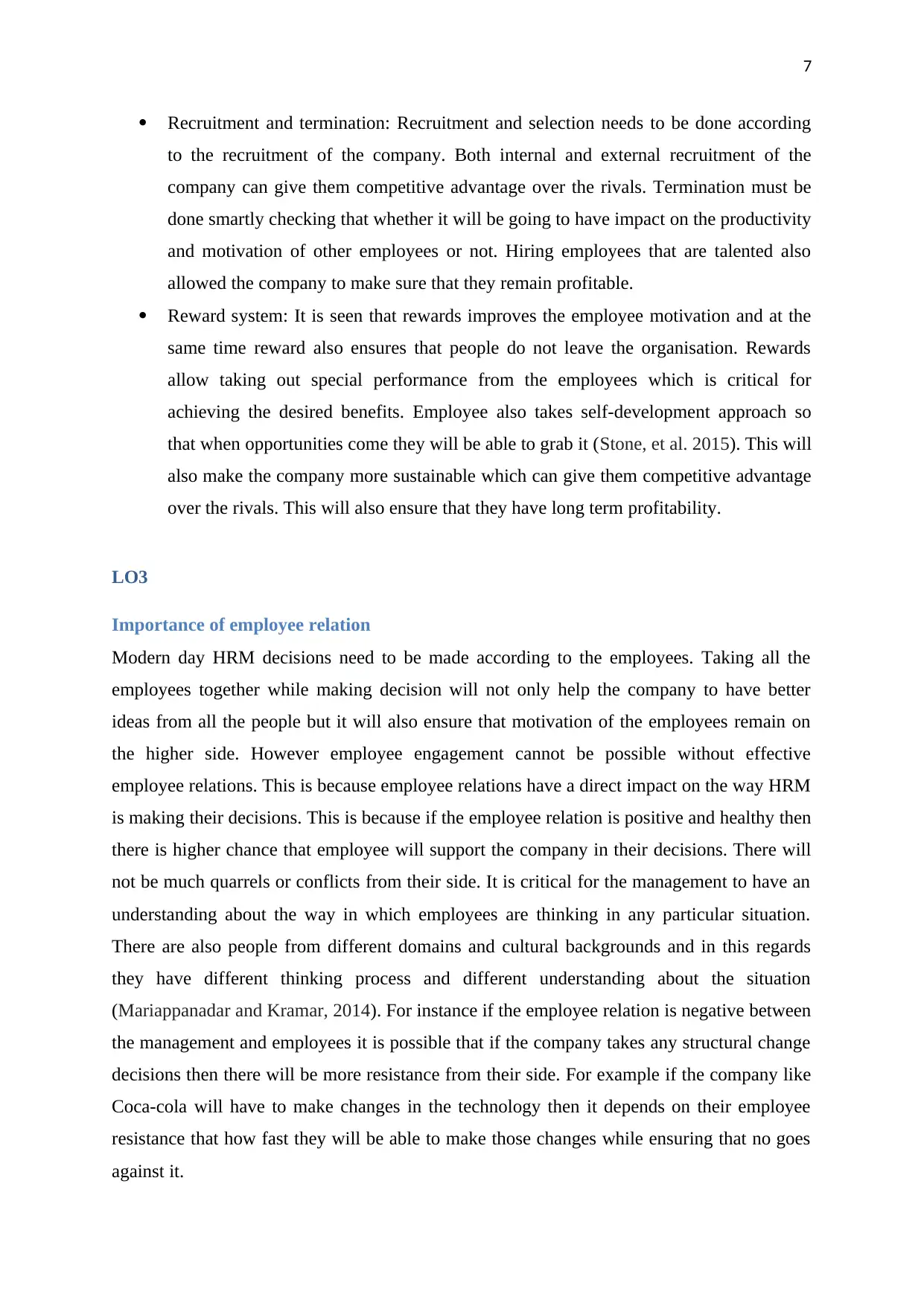
7
Recruitment and termination: Recruitment and selection needs to be done according
to the recruitment of the company. Both internal and external recruitment of the
company can give them competitive advantage over the rivals. Termination must be
done smartly checking that whether it will be going to have impact on the productivity
and motivation of other employees or not. Hiring employees that are talented also
allowed the company to make sure that they remain profitable.
Reward system: It is seen that rewards improves the employee motivation and at the
same time reward also ensures that people do not leave the organisation. Rewards
allow taking out special performance from the employees which is critical for
achieving the desired benefits. Employee also takes self-development approach so
that when opportunities come they will be able to grab it (Stone, et al. 2015). This will
also make the company more sustainable which can give them competitive advantage
over the rivals. This will also ensure that they have long term profitability.
LO3
Importance of employee relation
Modern day HRM decisions need to be made according to the employees. Taking all the
employees together while making decision will not only help the company to have better
ideas from all the people but it will also ensure that motivation of the employees remain on
the higher side. However employee engagement cannot be possible without effective
employee relations. This is because employee relations have a direct impact on the way HRM
is making their decisions. This is because if the employee relation is positive and healthy then
there is higher chance that employee will support the company in their decisions. There will
not be much quarrels or conflicts from their side. It is critical for the management to have an
understanding about the way in which employees are thinking in any particular situation.
There are also people from different domains and cultural backgrounds and in this regards
they have different thinking process and different understanding about the situation
(Mariappanadar and Kramar, 2014). For instance if the employee relation is negative between
the management and employees it is possible that if the company takes any structural change
decisions then there will be more resistance from their side. For example if the company like
Coca-cola will have to make changes in the technology then it depends on their employee
resistance that how fast they will be able to make those changes while ensuring that no goes
against it.
Recruitment and termination: Recruitment and selection needs to be done according
to the recruitment of the company. Both internal and external recruitment of the
company can give them competitive advantage over the rivals. Termination must be
done smartly checking that whether it will be going to have impact on the productivity
and motivation of other employees or not. Hiring employees that are talented also
allowed the company to make sure that they remain profitable.
Reward system: It is seen that rewards improves the employee motivation and at the
same time reward also ensures that people do not leave the organisation. Rewards
allow taking out special performance from the employees which is critical for
achieving the desired benefits. Employee also takes self-development approach so
that when opportunities come they will be able to grab it (Stone, et al. 2015). This will
also make the company more sustainable which can give them competitive advantage
over the rivals. This will also ensure that they have long term profitability.
LO3
Importance of employee relation
Modern day HRM decisions need to be made according to the employees. Taking all the
employees together while making decision will not only help the company to have better
ideas from all the people but it will also ensure that motivation of the employees remain on
the higher side. However employee engagement cannot be possible without effective
employee relations. This is because employee relations have a direct impact on the way HRM
is making their decisions. This is because if the employee relation is positive and healthy then
there is higher chance that employee will support the company in their decisions. There will
not be much quarrels or conflicts from their side. It is critical for the management to have an
understanding about the way in which employees are thinking in any particular situation.
There are also people from different domains and cultural backgrounds and in this regards
they have different thinking process and different understanding about the situation
(Mariappanadar and Kramar, 2014). For instance if the employee relation is negative between
the management and employees it is possible that if the company takes any structural change
decisions then there will be more resistance from their side. For example if the company like
Coca-cola will have to make changes in the technology then it depends on their employee
resistance that how fast they will be able to make those changes while ensuring that no goes
against it.
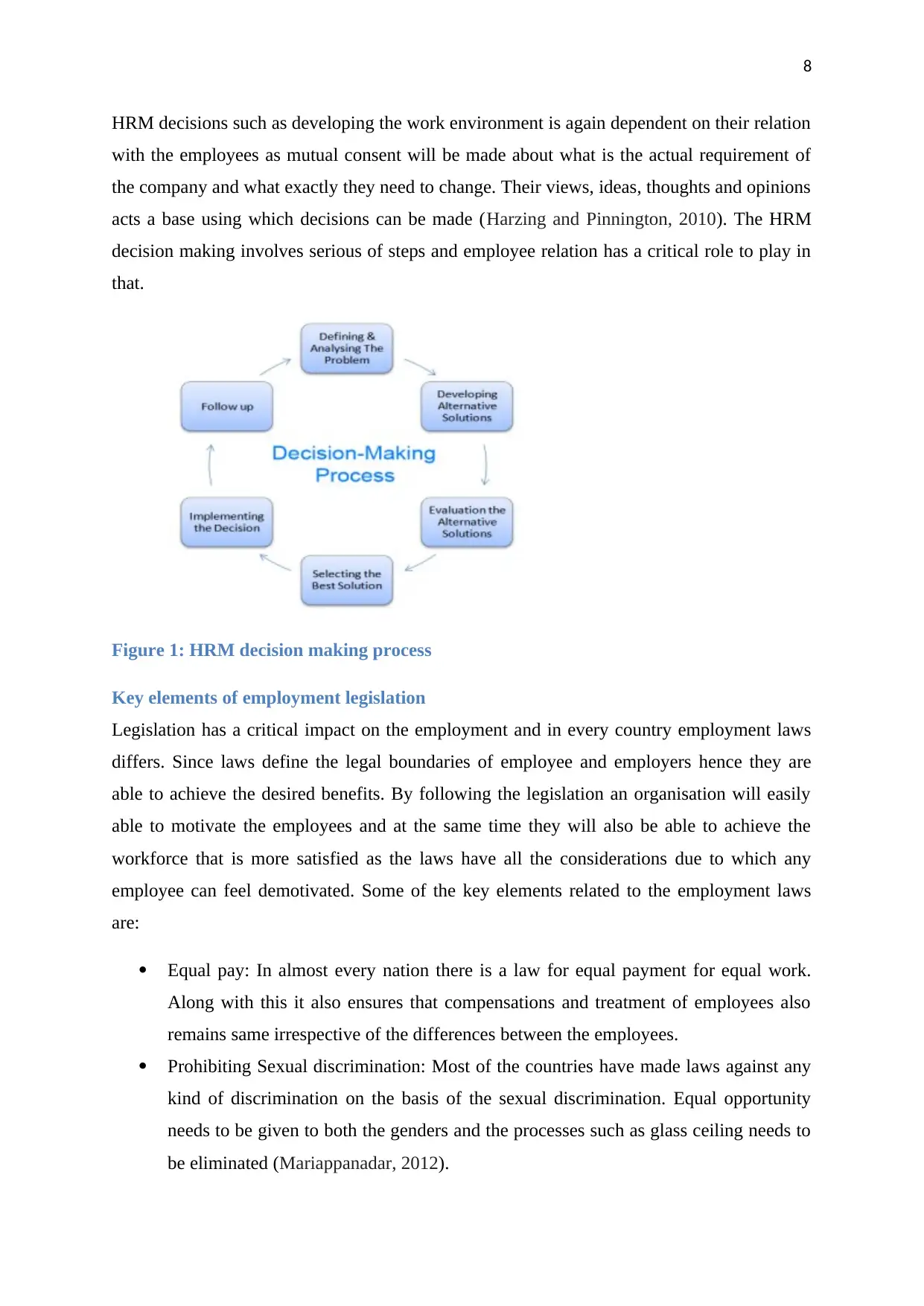
8
HRM decisions such as developing the work environment is again dependent on their relation
with the employees as mutual consent will be made about what is the actual requirement of
the company and what exactly they need to change. Their views, ideas, thoughts and opinions
acts a base using which decisions can be made (Harzing and Pinnington, 2010). The HRM
decision making involves serious of steps and employee relation has a critical role to play in
that.
Figure 1: HRM decision making process
Key elements of employment legislation
Legislation has a critical impact on the employment and in every country employment laws
differs. Since laws define the legal boundaries of employee and employers hence they are
able to achieve the desired benefits. By following the legislation an organisation will easily
able to motivate the employees and at the same time they will also be able to achieve the
workforce that is more satisfied as the laws have all the considerations due to which any
employee can feel demotivated. Some of the key elements related to the employment laws
are:
Equal pay: In almost every nation there is a law for equal payment for equal work.
Along with this it also ensures that compensations and treatment of employees also
remains same irrespective of the differences between the employees.
Prohibiting Sexual discrimination: Most of the countries have made laws against any
kind of discrimination on the basis of the sexual discrimination. Equal opportunity
needs to be given to both the genders and the processes such as glass ceiling needs to
be eliminated (Mariappanadar, 2012).
HRM decisions such as developing the work environment is again dependent on their relation
with the employees as mutual consent will be made about what is the actual requirement of
the company and what exactly they need to change. Their views, ideas, thoughts and opinions
acts a base using which decisions can be made (Harzing and Pinnington, 2010). The HRM
decision making involves serious of steps and employee relation has a critical role to play in
that.
Figure 1: HRM decision making process
Key elements of employment legislation
Legislation has a critical impact on the employment and in every country employment laws
differs. Since laws define the legal boundaries of employee and employers hence they are
able to achieve the desired benefits. By following the legislation an organisation will easily
able to motivate the employees and at the same time they will also be able to achieve the
workforce that is more satisfied as the laws have all the considerations due to which any
employee can feel demotivated. Some of the key elements related to the employment laws
are:
Equal pay: In almost every nation there is a law for equal payment for equal work.
Along with this it also ensures that compensations and treatment of employees also
remains same irrespective of the differences between the employees.
Prohibiting Sexual discrimination: Most of the countries have made laws against any
kind of discrimination on the basis of the sexual discrimination. Equal opportunity
needs to be given to both the genders and the processes such as glass ceiling needs to
be eliminated (Mariappanadar, 2012).
⊘ This is a preview!⊘
Do you want full access?
Subscribe today to unlock all pages.

Trusted by 1+ million students worldwide
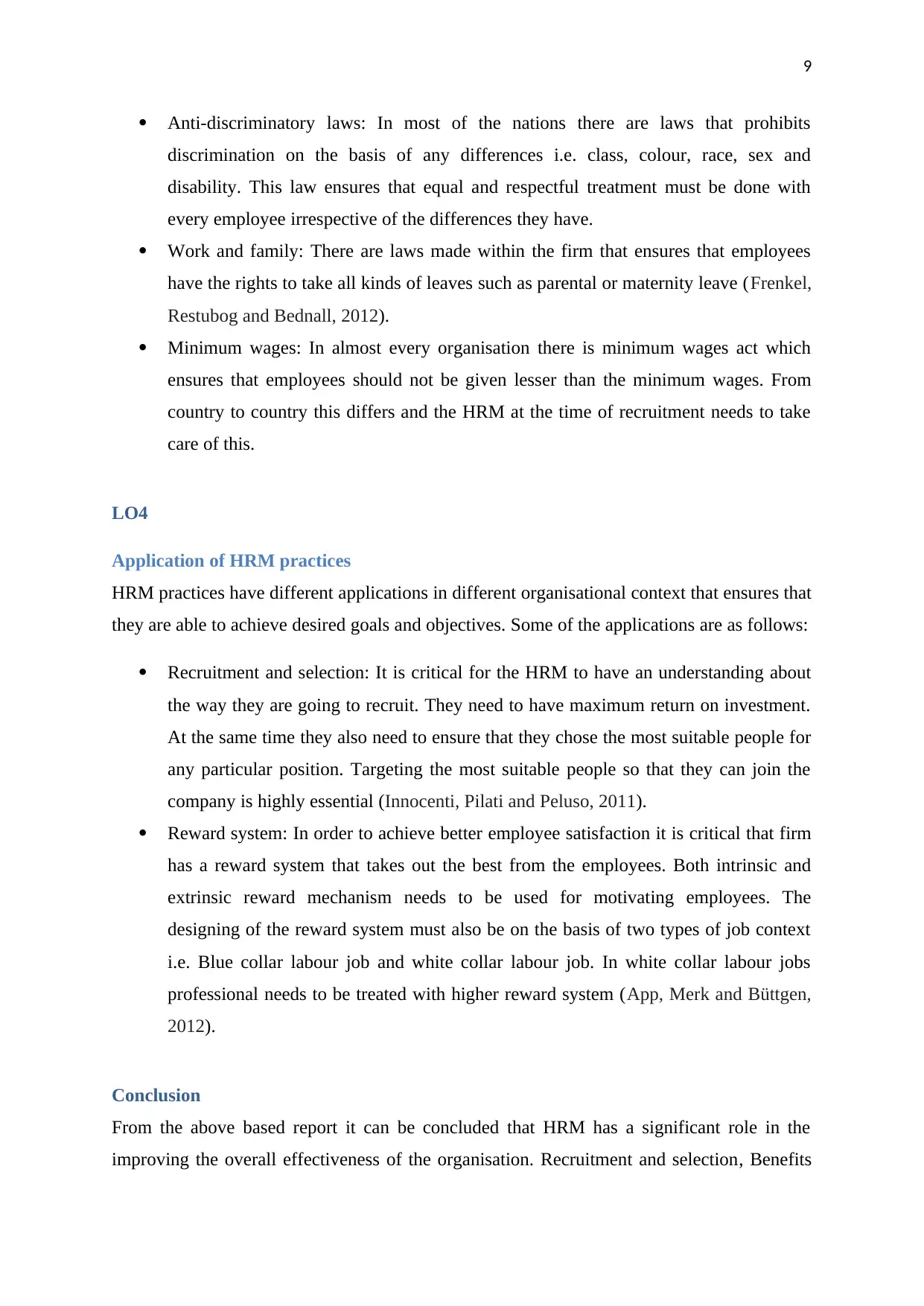
9
Anti-discriminatory laws: In most of the nations there are laws that prohibits
discrimination on the basis of any differences i.e. class, colour, race, sex and
disability. This law ensures that equal and respectful treatment must be done with
every employee irrespective of the differences they have.
Work and family: There are laws made within the firm that ensures that employees
have the rights to take all kinds of leaves such as parental or maternity leave (Frenkel,
Restubog and Bednall, 2012).
Minimum wages: In almost every organisation there is minimum wages act which
ensures that employees should not be given lesser than the minimum wages. From
country to country this differs and the HRM at the time of recruitment needs to take
care of this.
LO4
Application of HRM practices
HRM practices have different applications in different organisational context that ensures that
they are able to achieve desired goals and objectives. Some of the applications are as follows:
Recruitment and selection: It is critical for the HRM to have an understanding about
the way they are going to recruit. They need to have maximum return on investment.
At the same time they also need to ensure that they chose the most suitable people for
any particular position. Targeting the most suitable people so that they can join the
company is highly essential (Innocenti, Pilati and Peluso, 2011).
Reward system: In order to achieve better employee satisfaction it is critical that firm
has a reward system that takes out the best from the employees. Both intrinsic and
extrinsic reward mechanism needs to be used for motivating employees. The
designing of the reward system must also be on the basis of two types of job context
i.e. Blue collar labour job and white collar labour job. In white collar labour jobs
professional needs to be treated with higher reward system (App, Merk and Büttgen,
2012).
Conclusion
From the above based report it can be concluded that HRM has a significant role in the
improving the overall effectiveness of the organisation. Recruitment and selection, Benefits
Anti-discriminatory laws: In most of the nations there are laws that prohibits
discrimination on the basis of any differences i.e. class, colour, race, sex and
disability. This law ensures that equal and respectful treatment must be done with
every employee irrespective of the differences they have.
Work and family: There are laws made within the firm that ensures that employees
have the rights to take all kinds of leaves such as parental or maternity leave (Frenkel,
Restubog and Bednall, 2012).
Minimum wages: In almost every organisation there is minimum wages act which
ensures that employees should not be given lesser than the minimum wages. From
country to country this differs and the HRM at the time of recruitment needs to take
care of this.
LO4
Application of HRM practices
HRM practices have different applications in different organisational context that ensures that
they are able to achieve desired goals and objectives. Some of the applications are as follows:
Recruitment and selection: It is critical for the HRM to have an understanding about
the way they are going to recruit. They need to have maximum return on investment.
At the same time they also need to ensure that they chose the most suitable people for
any particular position. Targeting the most suitable people so that they can join the
company is highly essential (Innocenti, Pilati and Peluso, 2011).
Reward system: In order to achieve better employee satisfaction it is critical that firm
has a reward system that takes out the best from the employees. Both intrinsic and
extrinsic reward mechanism needs to be used for motivating employees. The
designing of the reward system must also be on the basis of two types of job context
i.e. Blue collar labour job and white collar labour job. In white collar labour jobs
professional needs to be treated with higher reward system (App, Merk and Büttgen,
2012).
Conclusion
From the above based report it can be concluded that HRM has a significant role in the
improving the overall effectiveness of the organisation. Recruitment and selection, Benefits
Paraphrase This Document
Need a fresh take? Get an instant paraphrase of this document with our AI Paraphraser
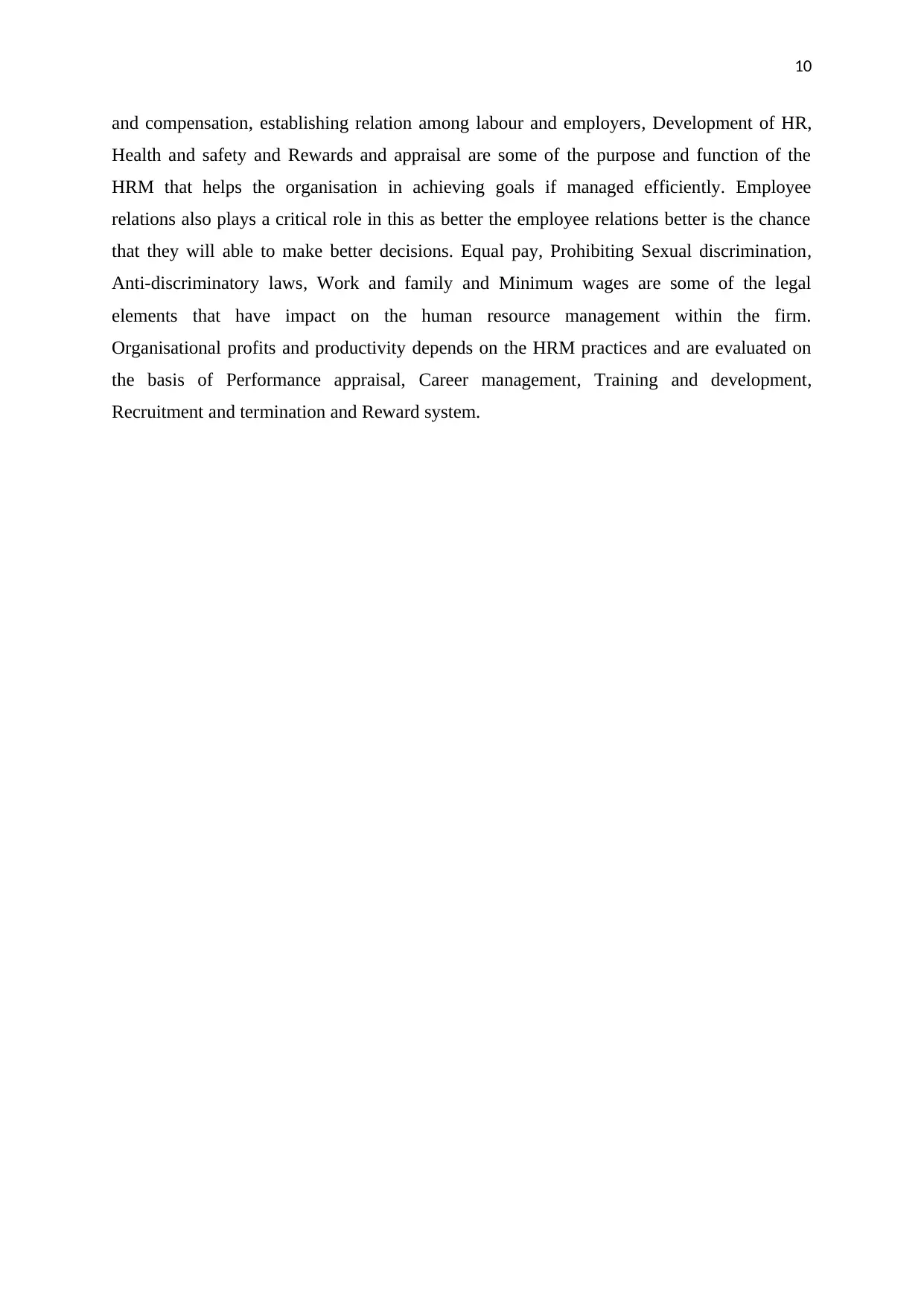
10
and compensation, establishing relation among labour and employers, Development of HR,
Health and safety and Rewards and appraisal are some of the purpose and function of the
HRM that helps the organisation in achieving goals if managed efficiently. Employee
relations also plays a critical role in this as better the employee relations better is the chance
that they will able to make better decisions. Equal pay, Prohibiting Sexual discrimination,
Anti-discriminatory laws, Work and family and Minimum wages are some of the legal
elements that have impact on the human resource management within the firm.
Organisational profits and productivity depends on the HRM practices and are evaluated on
the basis of Performance appraisal, Career management, Training and development,
Recruitment and termination and Reward system.
and compensation, establishing relation among labour and employers, Development of HR,
Health and safety and Rewards and appraisal are some of the purpose and function of the
HRM that helps the organisation in achieving goals if managed efficiently. Employee
relations also plays a critical role in this as better the employee relations better is the chance
that they will able to make better decisions. Equal pay, Prohibiting Sexual discrimination,
Anti-discriminatory laws, Work and family and Minimum wages are some of the legal
elements that have impact on the human resource management within the firm.
Organisational profits and productivity depends on the HRM practices and are evaluated on
the basis of Performance appraisal, Career management, Training and development,
Recruitment and termination and Reward system.
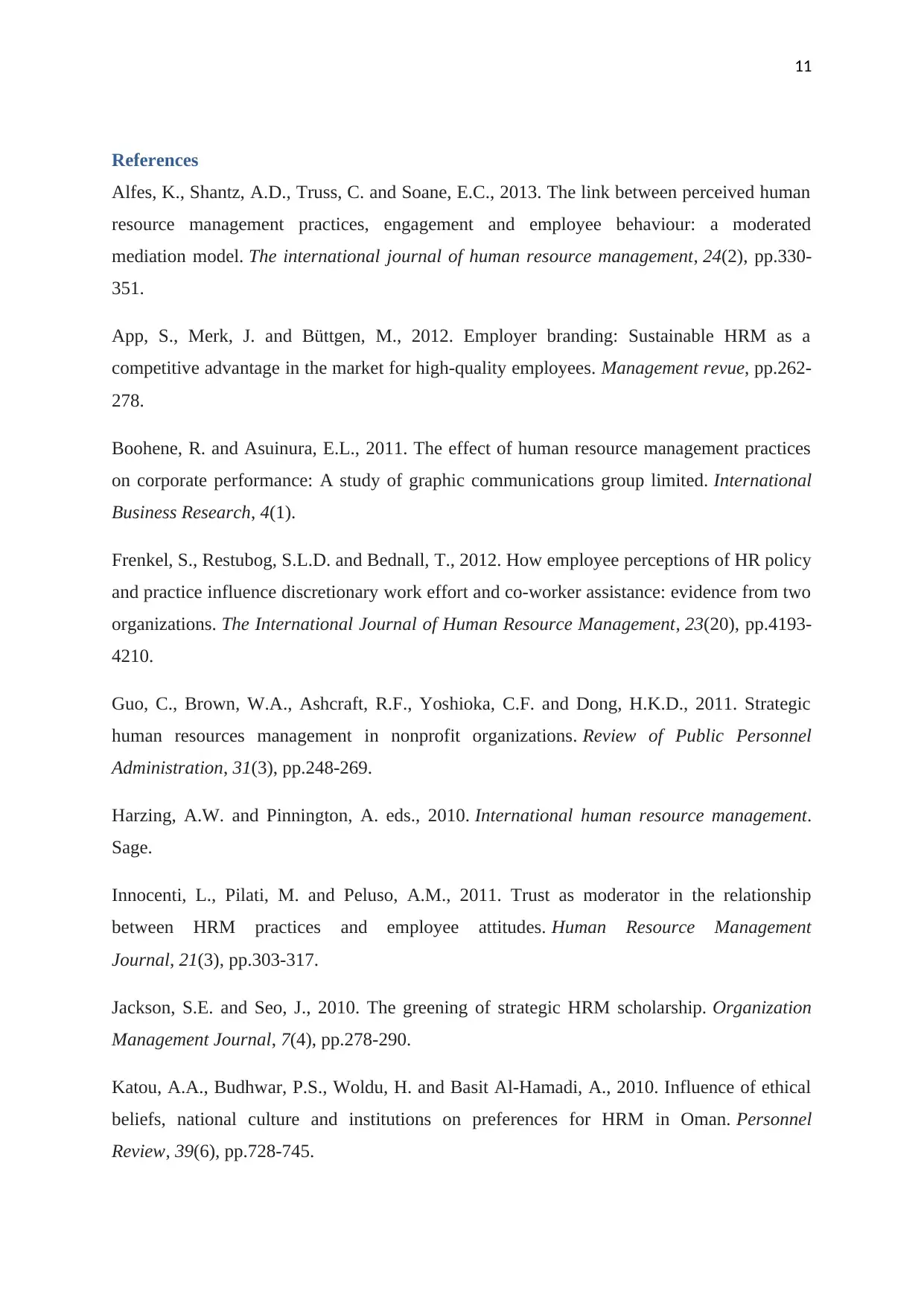
11
References
Alfes, K., Shantz, A.D., Truss, C. and Soane, E.C., 2013. The link between perceived human
resource management practices, engagement and employee behaviour: a moderated
mediation model. The international journal of human resource management, 24(2), pp.330-
351.
App, S., Merk, J. and Büttgen, M., 2012. Employer branding: Sustainable HRM as a
competitive advantage in the market for high-quality employees. Management revue, pp.262-
278.
Boohene, R. and Asuinura, E.L., 2011. The effect of human resource management practices
on corporate performance: A study of graphic communications group limited. International
Business Research, 4(1).
Frenkel, S., Restubog, S.L.D. and Bednall, T., 2012. How employee perceptions of HR policy
and practice influence discretionary work effort and co-worker assistance: evidence from two
organizations. The International Journal of Human Resource Management, 23(20), pp.4193-
4210.
Guo, C., Brown, W.A., Ashcraft, R.F., Yoshioka, C.F. and Dong, H.K.D., 2011. Strategic
human resources management in nonprofit organizations. Review of Public Personnel
Administration, 31(3), pp.248-269.
Harzing, A.W. and Pinnington, A. eds., 2010. International human resource management.
Sage.
Innocenti, L., Pilati, M. and Peluso, A.M., 2011. Trust as moderator in the relationship
between HRM practices and employee attitudes. Human Resource Management
Journal, 21(3), pp.303-317.
Jackson, S.E. and Seo, J., 2010. The greening of strategic HRM scholarship. Organization
Management Journal, 7(4), pp.278-290.
Katou, A.A., Budhwar, P.S., Woldu, H. and Basit Al-Hamadi, A., 2010. Influence of ethical
beliefs, national culture and institutions on preferences for HRM in Oman. Personnel
Review, 39(6), pp.728-745.
References
Alfes, K., Shantz, A.D., Truss, C. and Soane, E.C., 2013. The link between perceived human
resource management practices, engagement and employee behaviour: a moderated
mediation model. The international journal of human resource management, 24(2), pp.330-
351.
App, S., Merk, J. and Büttgen, M., 2012. Employer branding: Sustainable HRM as a
competitive advantage in the market for high-quality employees. Management revue, pp.262-
278.
Boohene, R. and Asuinura, E.L., 2011. The effect of human resource management practices
on corporate performance: A study of graphic communications group limited. International
Business Research, 4(1).
Frenkel, S., Restubog, S.L.D. and Bednall, T., 2012. How employee perceptions of HR policy
and practice influence discretionary work effort and co-worker assistance: evidence from two
organizations. The International Journal of Human Resource Management, 23(20), pp.4193-
4210.
Guo, C., Brown, W.A., Ashcraft, R.F., Yoshioka, C.F. and Dong, H.K.D., 2011. Strategic
human resources management in nonprofit organizations. Review of Public Personnel
Administration, 31(3), pp.248-269.
Harzing, A.W. and Pinnington, A. eds., 2010. International human resource management.
Sage.
Innocenti, L., Pilati, M. and Peluso, A.M., 2011. Trust as moderator in the relationship
between HRM practices and employee attitudes. Human Resource Management
Journal, 21(3), pp.303-317.
Jackson, S.E. and Seo, J., 2010. The greening of strategic HRM scholarship. Organization
Management Journal, 7(4), pp.278-290.
Katou, A.A., Budhwar, P.S., Woldu, H. and Basit Al-Hamadi, A., 2010. Influence of ethical
beliefs, national culture and institutions on preferences for HRM in Oman. Personnel
Review, 39(6), pp.728-745.
⊘ This is a preview!⊘
Do you want full access?
Subscribe today to unlock all pages.

Trusted by 1+ million students worldwide
1 out of 14
Related Documents
Your All-in-One AI-Powered Toolkit for Academic Success.
+13062052269
info@desklib.com
Available 24*7 on WhatsApp / Email
![[object Object]](/_next/static/media/star-bottom.7253800d.svg)
Unlock your academic potential
Copyright © 2020–2025 A2Z Services. All Rights Reserved. Developed and managed by ZUCOL.





